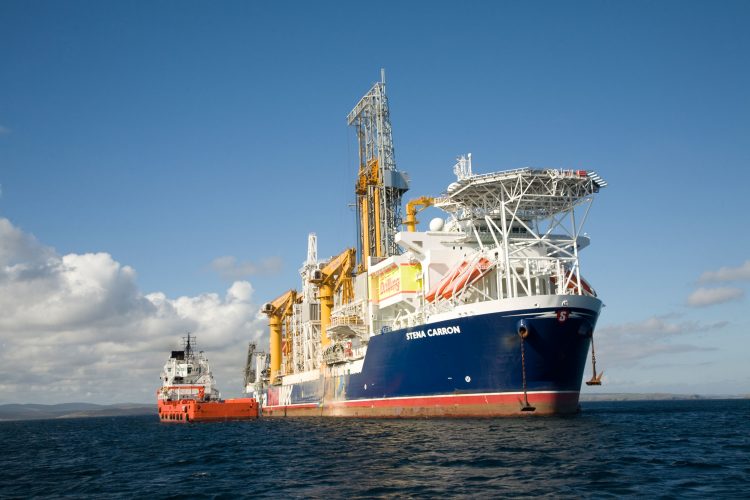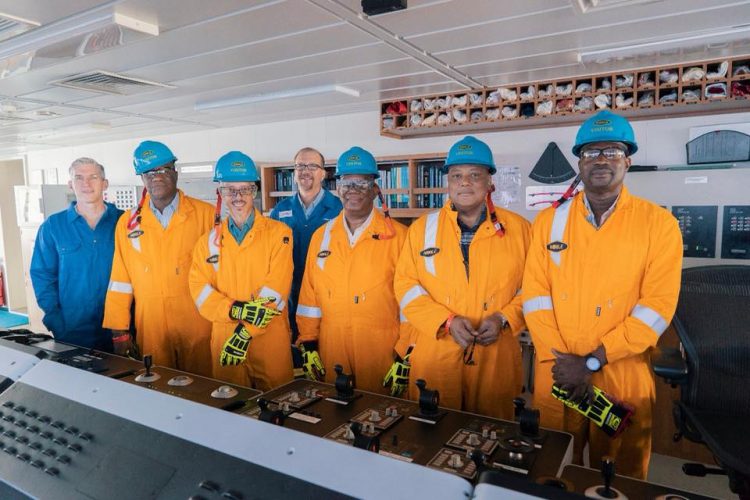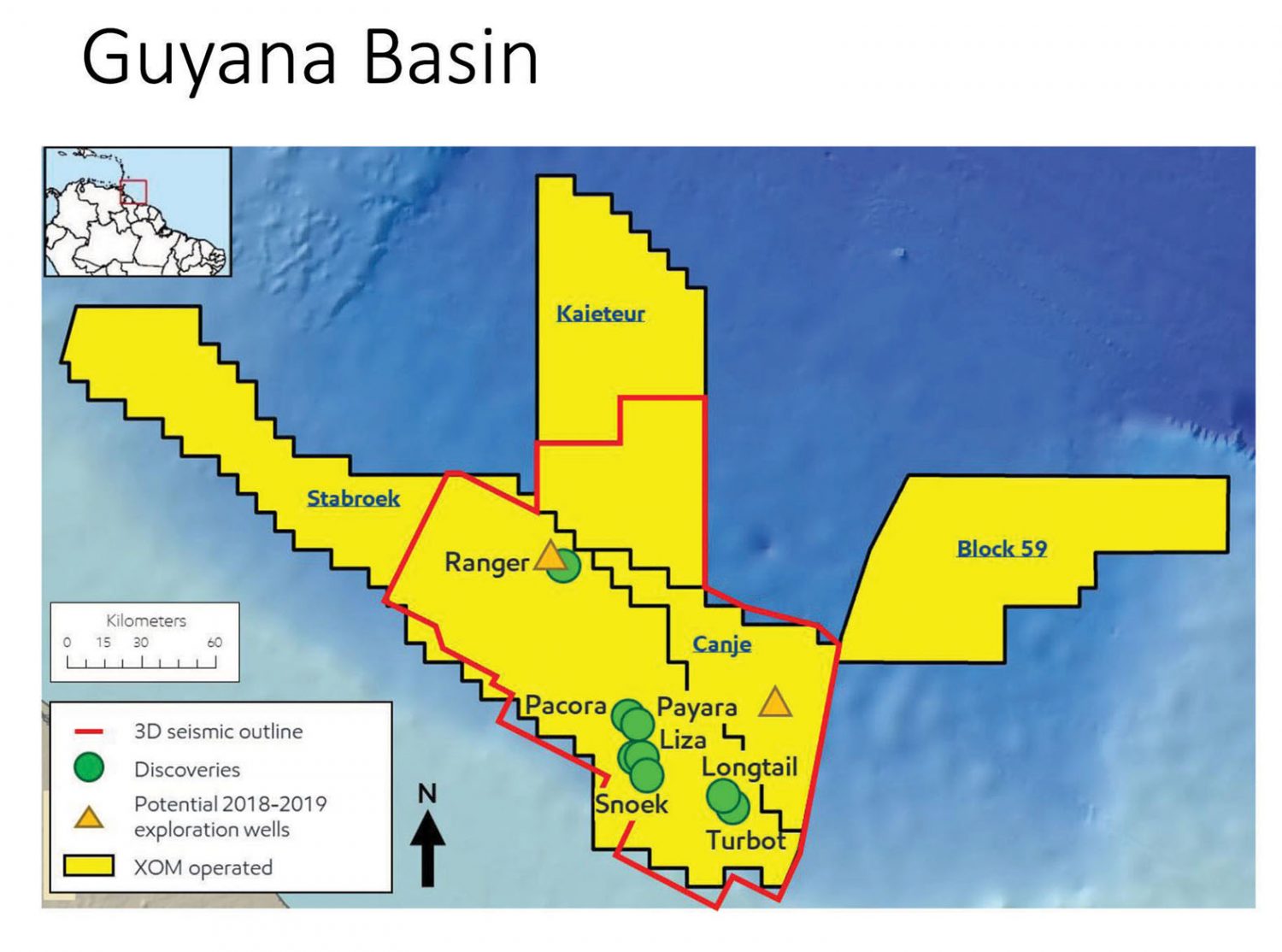With an eighth oil find yesterday in the Guyana basin and its largest discovery still to be quantified, ExxonMobil’s estimated total for seven wells in the Stabroek Block stands at some 3.7 billion recoverable oil-equivalent barrels, even as the company accelerates work in the zone by adding a third drillship.
Update: ExxonMobil says eighth well discovery still to be quantified
“We have not assigned an estimate for Ranger yet. We need more data before we can do that and plan to drill a second well at Ranger this year. So the remaining seven discoveries are estimated at more than 3.7 billion barrels of oil equivalent,” Exxon-Mobil’s Public and Government Affairs Advisor, Kimberly Brasington, said in response to questions from the Stabroek News.
The company yesterday announced its eighth oil discovery offshore Guyana at the Longtail-1 well, creating the potential for additional resource development in the southeast area of the Stabroek Block.
The Stabroek Block is 6.6 million acres (26,800 square kilometers). Esso Exploration and Production Guyana Limited is the operator and holds a 45 percent interest in the Stabroek Block. Hess Guyana Exploration Ltd holds a 30 percent interest and CNOOC Nexen Petroleum Guyana Limited holds a 25 percent interest.
In a release, Exxon-Mobil said it encountered approximately 256 feet (78 meters) of high-quality, oil-bearing sandstone reservoir. The well was safely drilled to 18,057 feet (5,504 meters) depth in 6,365 feet (1,940 meters) of water using the Stena Carron drillship, which began drilling on May 25, 2018.

“The Longtail discovery is in close proximity to the Turbot discovery southeast of the Liza field,” said Steve Greenlee, president of ExxonMobil Exploration Company. “Longtail drilling results are under evaluation. However, the combined estimated recoverable resources of Turbot and Longtail will exceed 500 million barrels of oil equivalent, and will contribute to the evaluation of development options in this eastern portion of the block.”
Starting with its very first discovery at the Liza 1 Well back in 2015, ExxonMobil’s Public and Government Affairs Advisor echoed part of Greenlee’s perspective and gave an overview of works to date within the Stabroek Block.
“Liza phase 1 will produce up to 120,000 barrels of oil per day. (The) total estimate for the entire Liza field is over 1 billion barrels. Liza phase 1 will produce about half of that, at 500 million barrels of oil equivalent. Liza Phase 2 will have a production capacity of 220,000 barrels per day and produce the remainder of the Liza field,” Brasington said.
“A third development, Payara, is planned to follow Liza Phase 2.The Longtail discovery is very close to the Turbot discovery, both are southeast of the Liza field. The combined estimated recoverable resources of Turbot and Longtail will exceed 500 million barrels of oil equivalent. It is too early to speculate on the development plans for Turbot and Longtail,” she added.
Brasington did not give a timeframe for the completion of the assessment of the Ranger well and it is unclear why after six months the company has not put up an estimate but one expert explained that “those things take time and have to go through an analysis process that cannot be rushed”.
However, the company has said that it was its biggest find and had expressed its gratification.
“This latest success operating in Guyana’s significant water depths illustrates our ultra-deepwater and carbonate exploration capabilities…this discovery proves a new play concept for the 6.6 million acre Stabroek Block, and adds further value to our growing Guyana portfolio,” Greenlee had said.
World-class
According to Exxon’s project overview of works in the Stabroek Block, the Liza-1 well discovery was announced in May, 2015. The Liza-2 well was drilled and tested in July, 2016, while the Liza-3 well was drilled in October, 2016, confirming a world-class resource discovery in excess of 1 billion oil-equivalent barrels. (Appraisal drilling at Liza-3 identified an additional high quality deeper reservoir directly below the Liza field, which is estimated to contain resources between 100 and 150 million oil-equivalent barrels.) The Liza-4 well was drilled in March, 2017 and more than 197 feet of high-quality, oil-bearing sandstone reservoirs, which will underpin a potential Liza Phase 2 development. Appraisal drilling at Liza 3 identified an additional high quality deeper reservoir directly below the Liza field, which is estimated to contain resources between 100 and 150 million oil-equivalent barrels.
Skipjack-1 was drilled in September 2016; this did not encounter commercial quantities of hydrocarbons.
Payara-1 well discovery was announced in January 2017; Payara is ExxonMobil’s second oil discovery on the Stabroek Block and was drilled in a new reservoir – encountering more than 95 feet of high quality, oil bearing sandstone reservoirs. The well was safely drilled to 18,080 feet (5,512 meters) in 6,660 feet (2,030 meters) of water.
Payara-2 well discovery was announced in July 2017; Payara-2 encountered 59 feet (18 meters) of high-quality, oil-bearing sandstone reservoirs. The well was safely drilled to 19,068 feet (5,812 meters) in approximately 7,000 feet (2,135 meters) of water. The Payara discovery is estimated at approximately 500 million oil-equivalent barrels.
Snoek-1 well discovery was announced in March 2017; Snoek is ExxonMobil’s third oil discovery on the Stabroek Block and was drilled in a new reservoir – encountering 82 feet (25 meters) of high-quality, oil-bearing sandstone reservoir. The well was safely drilled to 16,978 feet (5,175 meters) in 5,128 feet (1,563 meters) of water.
Turbot-1 well discovery was announced in October 2017; Turbot is ExxonMobil’s fifth oil discovery on the Stabroek Block and was drilled in a new reservoir – encountering approximately 75 feet (23 meters) of high-quality, oil-bearing sandstone reservoir. The well was safely drilled to 18,445 feet (5,622 meters) in 5,912 feet (1,802 meters) of water.
Ranger-1 well discovery was announced in January 2018; Ranger is ExxonMobil’s sixth oil discovery on the Stabroek Block and was drilled in a new reservoir- encountering approximately 230 feet (70 meters) of high-quality, oil-bearing carbonate reservoir. The well was safely drilled to 21,161 feet (6,450 meters) depth in 8,973 feet (2,735 meters) of water but no estimate as yet.
Pacora-1 well discovery was announced in February 2018; Pacora is ExxonMobil’s seventh oil discovery on the Stabroek Block and was drilled in a new reservoir- encountering approximately 65 feet (20 meters) of high-quality, oil-bearing sandstone reservoir. The well was safely drilled to 18,363 feet (5,597 meters) depth in 6,781 feet (2,067 meters) of water
Sorubim-1 was drilled three months ago in April 2018; but this well did not encounter commercial quantities of hydrocarbons and Longtail was drilled shortly after with the discovery made public yesterday.
‘Assurance’
Seeing the additional oil discovery as a further boost to its future economic and other development plans for the country, government expressed its excitement yesterday as it congratulated ExxonMobil and its partners.
“This discovery is as important as the other seven and we are happy that Exxon and co-ventures Hess and CNOOC Nexen are maintaining an active and aggressive work programme to explore the Stabroek Block. It is impressive that all this is being done without any accidents and delays and we congratulate the captain and crew of the Stena Carron for their sterling efforts. Government through its various ministries and agencies will continue to support the work of Exxon and other operators so that we can continue the development of the emerging industry,” Minister of Natural Resources Raphael Trotman told Stabroek News yesterday.
In a statement, government said too that it was equally delighted that ExxonMobil and its partners will bring a third drillship into Guyana’s waters, adding to the Stena Carron and the Noble Bob Douglas.

“The government views this not only as an unmistakable demonstration of ExxonMobil’s confidence in Guyana’s vast offshore reserves but also in the prudent management of our national affairs in general and the budding oil and gas sector specifically. This 8th discovery at Longtail-1 is yet another verification and validation of Guyana’s massive offshore oil reserves. All Guyanese will be brimming with further excitement of this historic news which reinforces that in the near future Guyana’s share of profit oil will allow for national infrastructural, economic and social transformation hitherto unimaginable,” the Department of Public Information (DPI) quoted Trotman as saying.
“The people of Guyana have the assurance that with the Coalition Government their country is in stable, responsible and judicious hands, managing with their best interest and the interest of future generations in mind…there are those who have expressed the desire for Guyana to begin embarking on an irresponsible spending and borrowing spree but we urge all Guyanese not to be baited by these pie-in-the-sky enticements and to understand that a sensible approach is what is required and advisable as we stride confidently towards first oil in May, 2020,” he added.
One expert explained that to have a company invest in three drill ships, of the magnitude of those ExxonMobil has and proposes to bring, in a newfound environment is noteworthy. “I am sure it is significant based upon what they know, or else they would not have invested such large sums of money in another ship,” one expert said.
Another explained, “Both regionally and internationally it is significant because although you might have three drillships in one area it usually is not for one company. Here we have one company and not just three ships but the class is huge and very very significant,” he said.
“I am sure also it is a part of a strategic overall programme because you have to remember they are carrying on an exploration programme at the same time they are carrying on a development programme. They have to make operational decisions, if they want to make all those logistical decisions, in a concurrent sense, to ensure all the scenarios possible at their fingertips. For example, if to adjoin a phase two to a phase three and so forth. If they drill and find another target near to a past discovery they would have missed the on-stream as the same time they were preparing. It has a cost factor too because you want to get all of that out while the cost for rental of those ships are at a low, such as now. Overall, it will better allow for planning,” he added.






